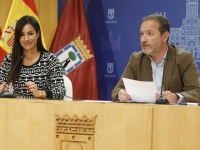News
9/10 people from Madrid live under the theory of 'the city of 15 minutes'
100% have a square or green area near
USPA NEWS -
The vast majority of residents of the city of Madrid have everything they need within 15 minutes or less on foot from their homes, with the exception of their workplace. A fact revealed by the delegate of the Urban Development Area, Mariano Fuentes, during the presentation, together with the deputy mayor, Begoña Villacís, of the report 'Madrid in 15 minutes'. This report corresponds to the first phase of a study prepared by the City Council's General Directorate of Strategic Planning on this urban theory. The main conclusion is that for nine out of ten inhabitants (92.7%), Madrid is already the city of 15 minutes.
As explained by Mariano Fuentes, "a methodology has been used that allows us to detect exactly the deficiencies to be able to correct them from the Area." The 15-minute isochrone has been taken as a reference, taking into account the streets and the actual path along which the inhabitants of Madrid walk (and not a straight line on the map) and the average speed of people of different ages, corresponding to a journey of 1.2 kilometers from each city gate (154,800 residential gates). The delegate of the Urban Development Area explained that 100% of the inhabitants of Madrid have a residential area (square, green area) 15 minutes away and 98.1% can access an urban park. 99.8% have bars or restaurants, food and non-food stores (clothing and footwear, bookstores, hardware stores, dry cleaners, among others) within a 15-minute walk, as well as pharmacies, hairdressers, banks, post office and other last-mile courier services (package transport focused on the last journey to be made in the final delivery), general medicine offices, dental clinics or veterinary centers.
The same percentage (99.8%) have a stop of the Municipal Transport Company (EMT) and 89.5% a metro station. In addition, 97.8% have access to the shared bicycle service. 97.3% arrive in 15 minutes at sports facilities, sports clubs and gyms. During that time, more than 90% access public or subsidized centers for all educational cycles, municipal sports facilities, academies and non-regulated training centers. 87.7% can go to health centers and 82% to a day center or residence for the elderly.
As for leisure, 80.5% of the inhabitants of Madrid have cinemas, theatres, performance halls/discotheques and exhibition spaces and art galleries. These percentages are somewhat lower in the case of municipal libraries, since the number of residents who have one within 15 minutes is 61.5% or, in the case of municipal sports centers, 57.6%.
Differences by neighborhoods
The less favorable situations, which do not respond to the 15-minute walk parameter, are due to three cases: New neighborhoods, contemporary extensions, which have not completed the execution or implementation of facilities and services; very low-density neighborhoods, conceived under an urban model that does not prioritize the proximity environment (urbanizations such as La Florida or Conde de Orgaz); and locations isolated by clear barriers, whether natural or infrastructure, with the continuum built as Cuatro Vientos.
In terms of mobility, the municipal person in charge of urban planning pointed out that "the central almond is perfectly covered," while "deficiencies are detected in neighborhoods without metro or suburban services", such as Butarque, El Cañaveral, Rejas, the eastern part de Barajas, Valdebebas, the Encinar de los Reyes, Fuentelarreina and Valdemarín-El Plantío. Sources also made reference to some enclaves such as the PAU of Carabanchel, Entrevías, Santa Eugenia, Valdebernardo or Aravaca, which depend solely on a single mobility option, frequently with a single distant access from the peripheral areas of the neighborhood, "and that it would be necessary to supplement with other options.”
Outside the M-30 ring road, the most consolidated areas (Puerta del Ángel, Carabanchel, Usera, Puente de Vallecas, Ciudad Lineal) and the peripheral historic centers (Hortaleza, Villaverde Bajo and Vicálvaro), and other enclaves such as the neighborhood del Pilar or los Rosales have the characteristics to function as a city in which it is possible to do most daily trips in 15 minutes.
Madrid City Council is committed to ensuring that "the PAUs have the same opportunities as the rest of the neighborhoods and are filled with life and activity," so that, based on this realistic study, "it will be possible to better plan the facilities missing." Fuentes has announced that he will open a participatory process for the residents of these areas to say how they would like their neighborhood to improve. He also opted for the mix of uses, to avoid zoning and increase the varied offer of services in all neighborhoods, one of the aspects included in the new urban regulations.
Liability for this article lies with the author, who also holds the copyright. Editorial content from USPA may be quoted on other websites as long as the quote comprises no more than 5% of the entire text, is marked as such and the source is named (via hyperlink).






